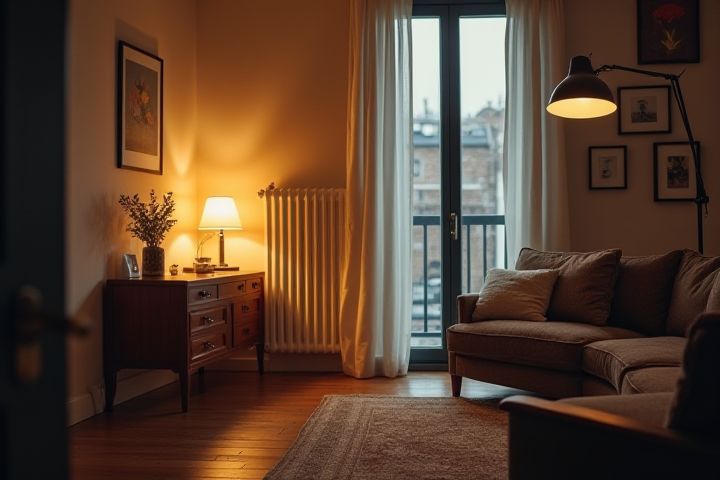
To effectively light your house interior, consider a layered approach by combining ambient, task, and accent lighting. Start with ambient lighting, which serves as the primary light source, using ceiling fixtures or recessed lights to create an overall warm glow that fills the room. For task lighting, implement focused sources, such as table lamps or under-cabinet lights in the kitchen, to illuminate areas where activities like reading or cooking take place. To add depth and visual interest, use accent lighting to highlight artwork or architectural features, employing spotlights or wall sconces strategically positioned for maximum effect. Finally, remember to utilize dimmers on your light switches to create a versatile atmosphere, allowing you to adjust the brightness according to your mood or occasion.
How To Light A House Interior
Layered lighting
Layered lighting enhances the ambiance and functionality of your interior spaces. Start with ambient lighting, which provides overall illumination; ceiling fixtures or recessed lights are common choices. Next, incorporate task lighting to facilitate activities, such as reading lamps or under-cabinet lights in kitchens. Finally, add accent lighting to highlight artwork or architectural features, using wall sconces or spotlights to create visual interest and depth in your home.
Natural light utilization
Maximize natural light in your home by strategically placing mirrors to reflect sunlight, enhancing brightness in darker areas. Use light-colored walls and furnishings to amplify the effect, as these surfaces will bounce light around the space. Opt for sheer window treatments that allow sunlight to filter in while maintaining privacy, providing a soft glow throughout your rooms. Finally, consider the layout of your furniture, ensuring it does not block windows, allowing light to flow freely and transform your interior atmosphere.
Dimmable fixtures
Dimmable fixtures are essential for creating versatile lighting moods in your home. By installing dimmable LED or incandescent bulbs in fixtures such as wall sconces, chandeliers, and recessed lights, you can effortlessly adjust the brightness to suit different activities, from reading to entertaining. Smart dimmers allow for remote control via mobile apps, enabling you to customize lighting scenes that enhance both functionality and ambiance. Consider strategically positioning your dimmable fixtures to highlight architectural features and artwork, transforming your house into a welcoming and stylish space.
Task lighting
Task lighting is essential for enhancing productivity and comfort in your home's interior. To effectively implement task lighting, consider specific areas where focused illumination is needed, such as reading nooks, kitchen countertops, and home offices. LED desk lamps, under-cabinet lighting, and pendant fixtures provide brilliant and adjustable light sources that cater to your activities. Ensure that the brightness is adequate to reduce eye strain while complementing the overall style of your home decor.
Accent lighting
Accent lighting enhances the aesthetic appeal of your home's interior by highlighting specific areas or features. To effectively implement accent lighting, consider using wall sconces, track lighting, or recessed lights to illuminate artwork, bookshelves, or architectural details. Dimmable LED bulbs are ideal for creating a flexible ambiance, allowing you to adjust brightness based on the time of day or activity. Using colored or decorative fixtures can also add a unique touch, enhancing your personal style and improving the overall atmosphere of your living space.
Color temperature
Color temperature, measured in Kelvins (K), plays a crucial role in creating the desired ambiance within your home. Warm white light, typically ranging from 2700K to 3000K, fosters a cozy and inviting atmosphere ideal for living spaces like the living room and bedrooms. Conversely, cooler light, around 4000K to 5000K, enhances focus and alertness, making it suitable for work areas or kitchens. To optimize your lighting, consider layering different light sources, such as using dimmable fixtures, LED bulbs, and strategically placed lamps, allowing you to adjust the color temperature to suit different activities and moods throughout your day.
Lighting control systems
Lighting control systems enhance your home's interior by providing customizable illumination suited to various activities and moods. Smart dimmers, daylight harvesting sensors, and programmable timers allow you to adjust brightness levels and create scenes that suit your lifestyle. By integrating these systems with mobile apps or voice-activated assistants, you can manage your lighting effortlessly, ensuring optimal energy efficiency and convenience. Consider incorporating zoned lighting controls to further enhance specific areas such as living rooms, kitchens, and workspaces, creating a harmonious atmosphere throughout your home.
Energy efficiency
To effectively light your house interior with a focus on energy efficiency, start by utilizing LED bulbs, which consume up to 80% less energy than traditional incandescent lights. Incorporate natural lighting through strategically placed mirrors and light-colored walls, enhancing daylight entry into the space. Use smart lighting solutions such as dimmers and timers that allow you to optimize energy use according to your routine. Finally, consider light fixtures with high energy ratings to ensure that your lighting not only illuminates but also conserves energy, contributing to lower utility bills.
Fixture style consistency
When lighting your house interior, prioritize fixture style consistency to create a harmonious atmosphere. Consider the overall theme of your space, whether it's modern, traditional, or eclectic, and select fixtures that enhance this aesthetic. For instance, if you opt for sleek, contemporary fixtures in the living room, extend that style into adjacent areas like the dining room and kitchen for a cohesive flow. Remember, the right fixtures not only provide necessary illumination but also serve as key decorative elements that elevate your home's design.
Shadow management
To effectively light your home's interior while managing shadows, consider using a layered lighting approach. Incorporate ambient lighting, such as ceiling fixtures or recessed lights, to create a uniform brightness of around 300-400 lumens per room. Supplement with task lighting, like table lamps or under-cabinet lights, to illuminate specific areas and reduce shadows by creating contrast with your ambient light. Finally, use accent lighting strategically to highlight architectural features or artwork, ensuring to position lights at angles that soften harsh shadows in living spaces.
